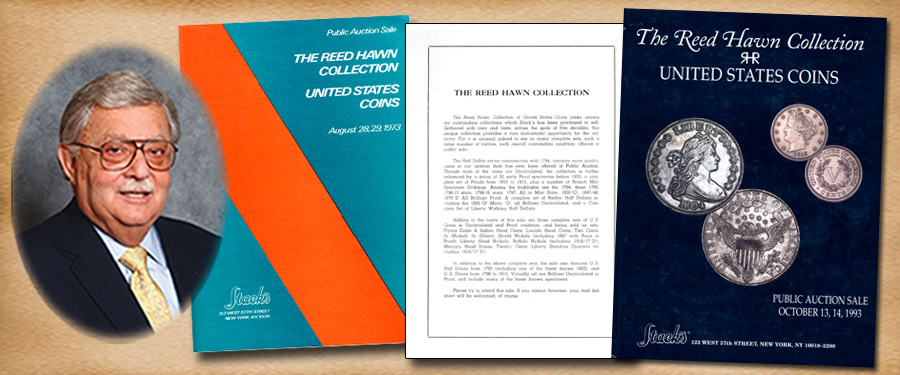
Reed Hawn, Connoisseur and Advocate
Reed Hawn, a Texas oilman and Arabian horse breeder, became known to the collecting world during the last quarter of the 20th century. He started collecting coins from change when he was nine years old, placing them in a coin album. He learned about rarity and quality from handling coins and reading all he could about them.
In 1961 at the age of 12, he and his family traveled to New York from Austin, Texas. Reed visited Stack’s and began his deep involvement in collecting rare and choice coins, initially with the help of his father, Bill Hawn, who felt that a hobby could offer education and possible investment for his young son.
By the time Reed reach age 24, he had assembled an outstanding collection of United States coins, with a specialty in half dollars. That collection was sold by Stack’s in New York in 1973, attracting collectors and buyers from all over the United States. Reed recalled in a later interview that the scope and quality of the coins he had assembled led to a standing room only auction venue, where it was difficult to get through the doors. Record prices were bid, large gains in value were attained, and Reed felt his connoisseurship, following guidance from the Stack family, led to the success of the sale.
His long time desire, even at the age of 24, was to own two coins heralded as "keys" to the American series. Shortly after the sale of his collection in 1973, he purchased the famous Mickley 1804 Class I silver dollar for $150,000 in a private sale from Stack’s. At the time this was a record price for any coin sold at auction or by private treaty. That coin is known today as the Mickley-Hawn Class I 1804 silver dollar.
The other prize he always wanted to own was a 1913 Liberty Head nickel, heralded during the 20th century as a great rarity. People were urged by coin dealers to "check their change daily" to find one. At one time, Col. E.H.R. Green owned all five known pieces, but most people never had the chance to own even one. However, the challenge of looking opened the field of coin collecting to many. During the Jerry Buss Collection sale in the late 1980s, the 1913 was offered and Reed bought it. Now he owned both his dream coins!
From the time he sold his first collection in 1973 until he decided he needed to sell the second in 1993 Reed traded other series of U.S. coins, from the cent to the double eagle. He sought the highest quality he could find and gathered some great rarities when they became available in the market. Many "finest knowns" were part of his holdings. His knowledge and connoisseurship continued to grow.
Reed Hawn’s great knowledge of numismatics, and his financial and monetary background led to his acting as advisor to Senator Lloyd Bentsen of Texas, for monetary and coinage matters. Later Reed was nominated and served for over a decade on both the Citizen’s Commemorative Advisory Committee for Congress and the U.S. Mint, and the Citizen’s Coinage Advisory Committee. When Lloyd Bentsen served as President Clinton’s First Secretary of the Treasury, Reed worked with the Treasury as he did during his time on the Advisory Committees.
While on the committees, he and Kenneth Bressett, a prominent numismatist, author and past president of the American Numismatic Association, argued with Mint officials and other members of the Advisory committee, about the large quantity of special coins being struck and the profit being made by the Mint. But they were unable to get the Mint to see the collectors’ point of view. Many new collectors left the hobby, as keeping up with the many Mint products was nearly impossible and losses were sustained by many who purchased them.
Reed Hawn developed a keen knowledge of the way Washington works and the way the Mint functions. Because of this and his background in numismatics and monetary matters, he was asked if he would consider the position of Mint director when candidates were being submitted to the Obama Administration in 2009,
When asked if he would consider the job, he said the of course he would. He felt he had the necessary background having worked so long with the Mint advisory committee, his relations with Lloyd Bentsen’s office, and his numismatic background.
When asked what he would he do as director, Reed responded that he would first listen and review what was done in the past. He would then make suggestions and take actions to improve the performance of the Mint. He would also address the ways coins were handled and sold by the Mint, which had resulted in citizen complaints about the high profits and overproduction of many Mint commemorative issues. He also noted that as a collector he knew what motivated individuals to collect and save. He felt that the Mint could improve how it treated collectors and that he would concentrate on that. As collectors supported the Mint through their purchase of commemorative products and coins with special finishes or strikings, Reed believed: "You got to treat them right!"
Reed Hawn’s collecting background and personal dedication to what collectors want and need inspires him to be an advocate for the collector, young and old. I personally believe that the next director of the Mint should be a current or past coin collector who understands what supply and demand does for a hobby. If he is still available when the job opens again, I would be the first the recommend and endorse the nomination of Reed Hawn.





